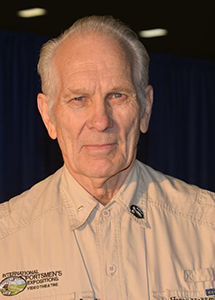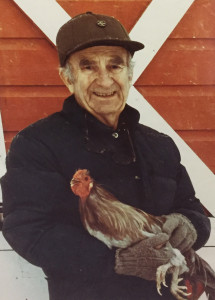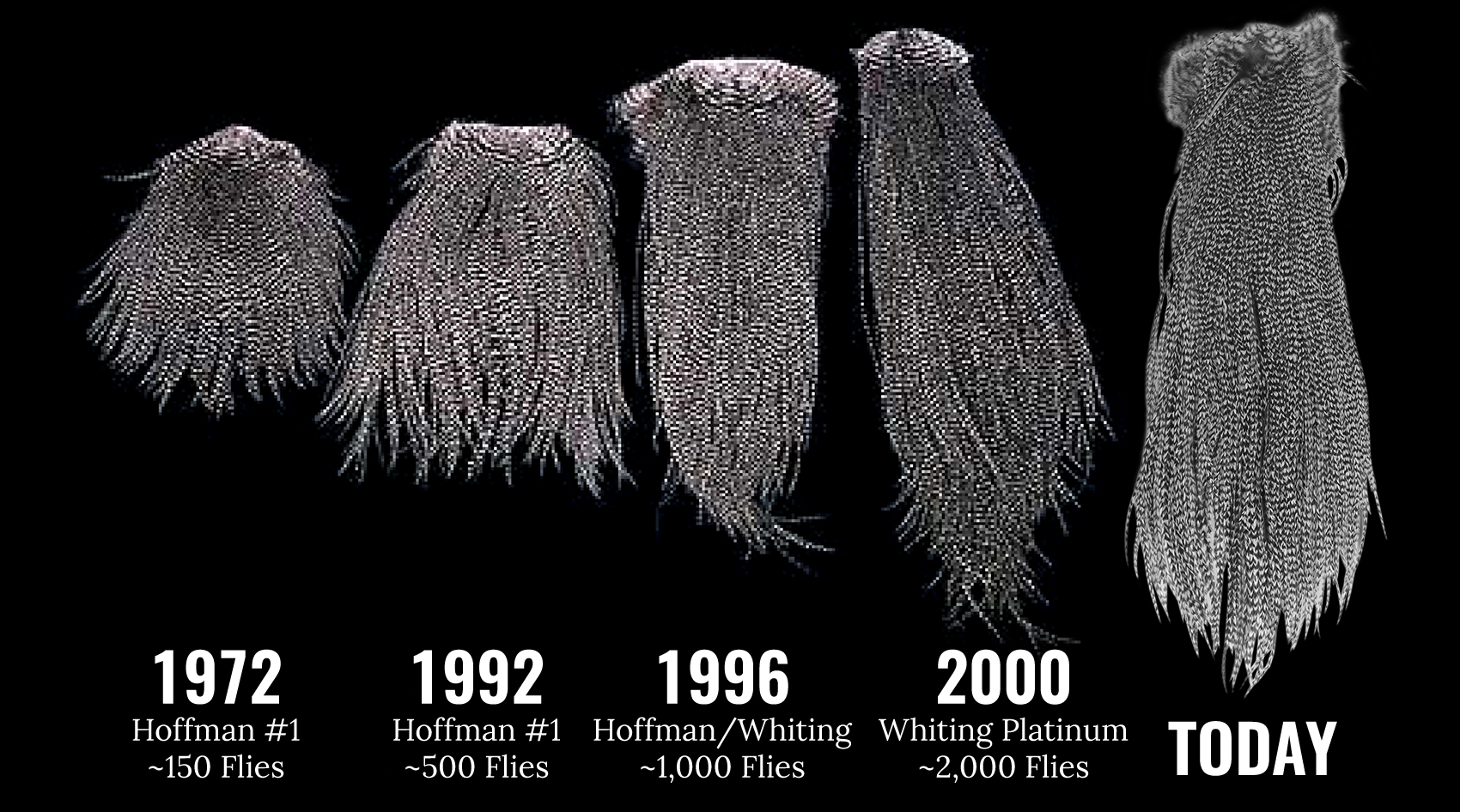Whiting Farms has had a long and colorful history! Like any business there is no way that we could have done this all by ourselves. Over the years we have formed some fairly important partnerships and we’d like to recognize those individuals who have contributed to the success of Whiting Farms over the years.

Backstory
From the mid 1960’s until 1989 Henry Hoffman of Warrenton, Oregon devoted his life to producing the best dry fly hackle in the world. His primary motivation was an all-consuming, life-long love of fishing. As an offshoot to this intense interest in fishing Henry also learned to tie flies, often by taking apart lost flies he found on the stream bank.
 Fortunately (for himself and the world) Henry was born into the right situation. His parents had a small meat chicken breeding operation in California, so Henry grew up learning the basics of poultry husbandry and breeder selection. After a stint in the military Henry settled in Oregon and made his living tying fishing flies commercially, predominantly “dry flies” which are flies that float on top of the water imitating an insect to attract wary fish.
Fortunately (for himself and the world) Henry was born into the right situation. His parents had a small meat chicken breeding operation in California, so Henry grew up learning the basics of poultry husbandry and breeder selection. After a stint in the military Henry settled in Oregon and made his living tying fishing flies commercially, predominantly “dry flies” which are flies that float on top of the water imitating an insect to attract wary fish.
In the 1960’s good quality feathers for tying dry flies were nearly impossible to come by, and tiers had to rely on rather poor quality capes imported from India or China – basically just pelted village chickens. A “cape” is a pelt with feathers from the rooster’s head and neck; a “saddle” is from its back. In addition, the black and white barred pattern feathers called grizzly did not exist in these village chickens, thus major fly patterns which required grizzly hackle garnered a premium price. Therefore Henry set out in the mid 1960’s to find himself some grizzly chickens to raise for his own tying needs and potentially to develop into a marketable genetic hackle line. He searched amongst the county fairs and poultry fanciers in the Pacific Northwest and finally found an exceptional trio of Barred Plymouth Rock bantams, which incredibly had excellent (for that time) dry fly capes and also a respectable dry fly saddle. By Henry’s own estimation these initial birds saved him 10 years of development time, and he was off and running.
Because Henry Hoffman was a commercial fly tier, using the hackle in his own work, he brought an end-user’s perspective to his breeder selection. Literally he’d tie flies with the feathers and the best tying feathers determined which roosters became the sires for the next generation. This tying performance criteria put Henry’s breeding program in a league of its own and earned the Hoffman Hackle rave reviews and a devout following.
Besides being passionate about fishing and fly tying, having a directly applicable family upbringing, finding truly exceptional foundation stock, and directing the stock’s genetic development by personally using their feathers, Henry did three other particularly fortunate things: First, he confined his breeding program exclusively to Grizzly for about the first 15 years, thus focusing on only one color (also the most important), which greatly accelerated progress. Secondly, Henry conceived of and meticulously developed the first and unquestionably the best dry fly saddle hackle, thus bringing to the tying world a major fly tying innovation. And the final very good aspect of Henry was he preferred to stay small and focus on quality instead of quantity. The Hoffman operation only grew to 2,200 roosters a year and was essentially a mom and pop operation where Henry and his wife Joyce did nearly everything, with help from other family members, including even Henry’s elderly mother and father.
By the 1980’s the Hoffman Grizzly was world famous, almost legendary, and very coveted. Their dry fly saddles had progressed markedly and were totally unique, having to be seen to be believed, with individual feathers up to 12 inches long! Henry had also expanded his color range to include white and brown, the other essentials in fly tying. But Henry wanted to get out from under the all-consuming work load and drudgery of his business before he was too old to enjoy an extended retirement of fishing. So he put his life’s work up for sale. Many were understandably interested, but few had all the necessary skills to further develop the potential in the Hoffman gene pool. What was needed was knowledge and ability in poultry genetics, production and processing, and an equally serious willingness and commitment to devote their professional life to this long term endeavor.
Whiting Farms Inc.
After 5 years or so of trying to sell his business Henry Hoffman eventually got a workable deal created with Thomas Whiting of Colorado. Tom was then finishing his Ph.D. at the University of Arkansas, and also had an M.S. degree from the University of Georgia and a B.S. degree from Colorado State University, always specializing in his particular areas of interest – poultry genetics and husbandry. In addition Tom had considerable industrial poultry experience, i.e., managing a commercial egg production complex in Colorado that produced 3 million eggs per week. Henry agreed to consult for 5 years to transfer his knowledge and to initially preserve continuity in the breeding program. Whiting chose western Colorado to set up the new venture, and in April 1989 hatched out his first Hoffman Hackle chicks there from eggs sent to him by Henry from Oregon. From about 5,000 birds that first year (1989) to over 60,000 birds harvested in 2015, Whiting Farms has risen to become the largest and dominant fly tying feather producer in the world market.

Wanting to expand the depth and breadth of feather offerings to the fly tiers of the world, Dr. Whiting spent the 1990s acquiring or creating new genetic lines of feather chickens.
Most notably, Whiting Farms acquired the next best genetic dry fly hackle stock in 1995 from Ted Hebert, known as Hebert Hackle, to complement its gene pool and product line. The Hebert/Miner™ hackle stock is renowned for their incredible dry fly capes and the widest, best and most unique array of natural colors of any hackle stock in the world.

Other fly tying chicken lines were either acquired or started from scratch. The most significant acquisition was a small importation of hatching eggs from Spain in the mid-1990s of the oldest known fly tying chicken, the Coq de Leon. Product lines developed entirely at Whiting Farms include the American Hackle wet fly product line (started in 1992), the Spey Hackle (1997), and the Brahma gray partridge substitute line (1996). Giant guinea fowl were also added to expand the feathers offered. Whiting Farms has grown to become the dominant supplier of fly tying feathers in terms of quality, value, product range and reputation. Currently clients in 48 states and 36 countries are supplied.
» For additional information on breeding click here to read the Poultry Breeders Roundtable article
Whiting Farms has production on 2 ranches in western Colorado with a central processing, shipping and administrative facility. With continual genetic progress Whiting Farms has been able to supply ever increasing quality, value and selection to the fly tiers of the world. To accommodate an across the board quality improvement in all product lines, Whiting Farms introduced the Olympic medal grade designations of Gold, Silver and Bronze in the 1999/2000 sales season. The purpose of this grade designation was to pass on the genetic and husbandry advances at Whiting Farms to the fly tiers of the world and to further distinguish Whiting Farms’ quality superiority. Basically the Whiting Farms Bronze grade is as good as and often better than any competitor’s top grade. And the Silver, Gold and Platinum grades are beyond all others. This grade improvement continues to this day.
Genetic hackle production is predominantly in America; there are only about a dozen producers presently, all but two of which are in the United States. Nevertheless, Whiting Farms sell their feather products world-wide. Japan is their largest single foreign market, with Canada, the European countries, Australia and New Zealand buying considerable quantities as well. Commercial fly tying factories in Singapore, Sri Lanka, Thailand, the Philippines, China, Kenya, South Africa, Bhutan and Brazil are also supplied by Whiting Farms. Newly developing consumer markets are also expanding in Argentina, Chile, South Africa, South Korea and the former Soviet Union countries. In all, Whiting Farms sell their products into 36 countries and 48 states.
In the late 1990s some “commercial” chicken lines began to be developed by Whiting Farms for the production of blue, green, brown and white egg shell stocks, as well as gourmet meat and guinea stocks. These lines have been developed to provide a high production alternative to industrial chicken stocks, with an emphasis on product quality, bird beauty and sustainability for backyard and small poultry producers.
Whiting Farms has received several awards over the years as a result of excellent business standing and contributions to the fly fishing industry. Click here to peruse a few of our over the years. We are especially proud to mention that in the Spring 2011 issue of Fly Tyers Magazine, Tom Whiting was the first recipient to receive the magazine’s Lifetime Achievement Award in the area of fly tying materials. To quote from the award article: “When talking with Tom, he always credits the hackle breeders who preceded him, but there’s no mistaking the fact that he is producing the highest quality hackle in the history of the craft; it is the standard by which all other hackle is judged.” In addition to being the recipient of several awards over the years, Whiting Farms has a very special award that we give as well. This award is call the Platinum Feather Award and is given to people who have mentored and helped Whiting Farms in many aspects. In fact, Whiting Farms would not be the company it is today without the contributions of our Platinum Feather Award Recipients. Please take a moment to read about them as they are very special to us.
Current Happenings on the Farm
In recent years Whiting Farms has undergone some exciting changes. We were able to decommission an older hatchery facility and build a new hatchery. The new hatchery is literally state-of-the-art in terms of new technology, floor plan, ventilation sophistication and even an energy recovery system. Each of the four incubators are the latest “single stage” technology where only one age group of eggs are set in each machine so the exact environment parameters can be maintained throughout the incubation process, which is about 21 days. Each of the three incubators and one “hatcher” (where the chicks actually hatch out at day 21) have capacities of 18,700 eggs each. The entire hatchery building was designed and built for an additional four incubators to accommodate future expansion, which is planned for late 2015.
In addition to the new hatchery we put into operation seven new barns to replace older barns. These new barns are also state-of-the-art. Rest assured the birds are well taken care of. One other new development that has been cost effective has been the installment and implementation of a large solar field. This solar field is able to produce enough power for several barns. Whiting Farms prides itself in being a green company. This solar field is only one way in which Whiting Farms stays green.
Interested in learning more? Click here.
Whiting Farms celebrated 25 years of genetic hackle production in 2015. To think it was just over 25 years ago when Tom Whiting hatched his first batch of Hoffman Hackle eggs. Look how far genetic hackle has come in that time.

Here is a quote from Dr. Tom’s Newsletter article in our 25th anniversary edition, “But really there would be no history of Whiting Farms without the fly tiers who buy our feathers. So I thank you all for your patronage, suggestions and support. I just still can’t believe it has been 25 years.”
If you would like to keep up with the latest news from Whiting Farms, please join our Newsletter list. It comes out about four times a year by email. If you miss an issue you can always catch up on past issues online.
The mission of Whiting Farms, Inc., from its inception in 1989, has been to be THE producer of the highest quality fly tying feathers for the world. We continue to be committed to this mission.

